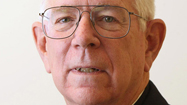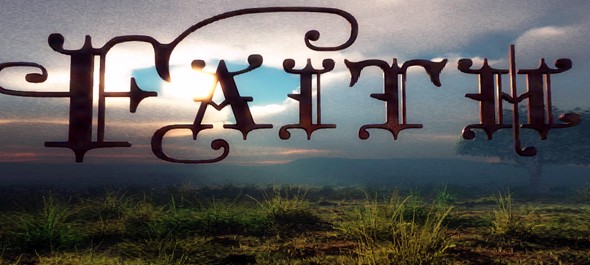Living faith is a beautiful thing
When we bury the dead, we think their lives complete. This may be a mortal’s error. Many years ago, my family gathered on a conference line to discuss what should happen with our mother, then in a coma. Some thought it best to wait and see while others hoped to keep her alive with any means at our disposal. And then one of us suggested that mother may be choosing to leave this world and meet her Lord. Sepsis soon overtook her and resolved our dilemma a few days later.

Jamie, Bryson and I went to Father Gerry Lardner’s funeral on Saturday in Catonsville. There we sat, a lapsed Jew, Lutheran and Catholic in awe at the interior of Our Lady of the Angels. Staring at the blue marble walls, cut through in mirror images and set one atop the other, running thirty feet up toward the roof. After noticing the gold leaf tile inlaid on the marble, this once Catholic heartily mused with the others about what Protestants, in their plainness, disliked most about Catholic regality and iconography.
A Sulpicion priest, trained here at St. Marys Seminary on Paca Street and Roland Avenue, Gerry took his vast talents for learning to California, to Notre Dame and overseas to London and Lusaka. But here he was, back in the parish of his early training, his casket open to view in front of the altar.
Ahead of the funeral, his brother Michael gave us a tour. Behind the altar, he showed us seven separate small altars where mass could be said simultaneously. Our mouths dropped open at the primitive Biblical scenes in pietre dure that backed the main altar. Taking it all in, one might easily think themselves in 8th century Constantinople. This was a structure built for the living practice of faith.
After Michael’s tour, we three found ourselves staring down at our friend, dressed in his cassock with rosary in crossed hands. Only weeks before, he sat with us at the coffee shop, happily explaining in detail the works of his cancer treatments. We could see then that cancer was taking more and more of his time.

Sulpicion priests in white robes, forming two rows as they walked down the center aisle of the church, began the service. Watching the procession, my mind quickly drifted to Gerry’s life. Having been given a brief bio written by Michael which he couldn’t read without choking up, I saw for myself that I knew so much of what his brother had written. That was part of Gerry and my kinship. Of church and school, family, education and the coming of age of Irish Catholics in this country. More than any of that, what most drew me to him was his faith.
Gerry’s faith, like my mother’s, was very much an experience. I do not carry this faith yet to know someone who does is to witness a singular beauty. I was able to see this in my mother only in the years after my father died. Her faith, like Gerry’s, was hers alone and not something she wholly shared. When either she or Gerry did, it was not with a truncheon’s blow, quoting scripture without adaptation. It was interpreted and elegant, nuanced and alive.
I watched Jamie and Bryson endure the sit, stand and kneel routine of mass only Catholics know and rarely forget while all the Sulpicions, in unison, professed the Mystery of Faith. The elderly usher grew huffy with us when I told her we were not taking communion. I knew, of course, that we had no right and explained to my self conscious friends that her unctuous behavior was her problem, not ours. By then, we had a few moments to reflect on the service for our friend. I thought of Gerry, whom I rarely saw angry and how he would have redressed the elderly usher for her lack of etiquette.
Remembering that mass is part devotion, part theater, the climax of the service came with the singing of “Salve Regina” in Latin. Just to hear the language, again sung by the Sulpicions and the pre Vatican II elders in the church, was to witness the heavens opening for the praying voices of mortals. Exquisite, the experience of faith. To hear them was to hear George Harrison’s “Wah-Wah,” a belting Krishna, rock and roll chant.
One cannot mention the Catholic Church these days without mentioning the sex abuse scandals. Let me say that the church hierarchy, from the States to Rome, has largely behaved abhorrently throughout. Their defensive stance, blaming others for their transgressions, reminds me of any punk who lawyers up once he’s been nabbed by the cops.
But within the church here and everywhere exist men and women like Gerry Lardner. Millions and millions of them. People whose relationship with Jesus is more than the worldwide apostolic movement. For them, nothing is so simple as exporting faith. For them, it is the challenge of living as an apostle and a human too.
Gerry never stopped reading, thinking or talking. In opposite to his athletic brother Michael, Gerry’s childhood refuge was in books. His father set up an account for him at a local bookstore, telling him he could get a new book only when he’d finished the last. And though we didn’t agree on a range of issues, our arguments were in depth, with no limits on what could be introduced.
We debated the lawsuit brought by Father John Jenkins of Notre Dame against the federal health care mandate concerning reproductive rights for women. This is the same Father Jenkins who happily and proudly introduced President Obama at the school’s 2009 commencement, amid angry shouts from the crowd. We largely agreed on the substance of Father Jenkins’ argument in defense of institutions of faith, even as I am pro choice. We also knew that so much of the debate had been taken over by people who know so little about what is at stake for either side. Even so, he hinted, time and again, that much of the debate would not matter if women had a greater place in the church.
Gerry would have liked my mother as I liked him. I wish they’d met. Maybe they will now that they’ve gone forward to the next life. She was a Catholic intellectual and pro life too, yet as she said on many occasions, “no man will tell me what to do with my body.” If they meet, I hope my friend Gerry is ready for Hazel Mary, who was a bit of a bad ass too.
Robert Emmet Mara has been in Baltimore since 2006. A native New Yorker, Robert came to Baltimore to do three things: work with kids, renovate houses and write a second book of fiction. Since his arrival, he has managed to do all three and more.
He has sought better oversight for his still blighted Harwood neighborhood from the city and has been asked to speak to various community association leaders on the subject of city agency relations.

